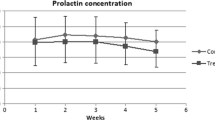Zusammenfassung
Ethanolic extracts of the fruits of Vitex agnus castus (AC) are widely used to effectively treat premenstrual symptoms. It was recently demonstrated that premenstrual symptoms, particularly premenstrual mastodynia are often accompanied by a latent hyperprolactinemia [4–6, 12, 16, 17]. Prolactin is a pituitary hormone produced by the so-called lactotropes. When high levels of the hormone circulate in the blood it stimulates lobulo-alveolar growth of mammary tissue and lactation. Hence, in latent hyperprolactinemic patients the mammary gland is unphysiologically stimulated and therefore so tender that each movement of the body or each tactile stimulus results in painful sensations. This latent hyperprolactinemia can be unmasked by injection of metoclopramide, a dopamine receptor blocking drug [5, 16]. Under physiological conditions this will result in prolactin release to values not higher than 4000 to 5000 µU/ml. Under the conditions of latent hyperprolactinemia, values exceeding these can be regularly achieved. Furthermore, latent hyperprolactinemia is often manifest during the time of decreasing progesterone and estradiol values prior to menstruation, i.e., during the premenstrual period [5]. Any stressful condition is also a stimulator of pituitary prolactin release. Hence, it is often observed that women have relatively high prolactin levels upon withdrawal of a blood sample, if a second or third blood sample is withdrawn through indwelling antecubital vein catheters, the serum prolactin levels drop down in most women. This stress response is also augmented in women suffering from latent hyperprolactinemia [5]. Prolactin episodes are also released during deep sleep phases and also these prolactin episodes are higher in amplitude and longer in time in latent hyperprolactinemic women in comparison to normal controls [16].
Access this chapter
Tax calculation will be finalised at checkout
Purchases are for personal use only
Preview
Unable to display preview. Download preview PDF.
Similar content being viewed by others
References
Baumgarten HG, Björklund A (1976) Neurotoxic indoleamines and monoamine neurons. Ann Rev Pharmacol Toxicol 16: 101–111
Bispink L, Brändle W, Lindner C, Bettendorf G (1989) Präklinische Hypothyreose und Ovarialfunktionsstörungen. Geburtsh u Frauenheilk 49: 881–888
Caine DB, Horowski R, McDonald RJ, Wuttke W (eds) (1983) Lisuride and other dopamine agonists. Raven Press, New York
Carrol BJ, Steiner M (1978) The psychobiology of premenstrual dysphoria: the role of prolactin. Psychoneuroendocrinology 3: 171–180
Dietrich M, Hinney B, Link M, Kuhn W, Wuttke W (1988) Latent hyperprolactinemia as a cause of mastodynia and luteal function impairment. Vth Int Congr Prolactin, Abstract P89
Halbreich U, Assad M, Ben-David M, Bornstein R (1976) Serum-prolactin in women with premenstrual syndrome. Lancet 654–656
Jarry H, Leonhardt S, Wuttke W, Behr B, Gorkow C (1991) Agnus castus als dopaminerges Wrrkprinzip in Mastodynon N. Zeitschrift für Phytotherapie 12: 77–82
Jany H, Leonhardt S, Gorkow C, Wuttke W (1994) In vitro prolactin but not LH and FSH release is inhibited by compounds in extracts of Agnus castus: direct evidence for a dopaminergic principle by the dopamine receptor assay. Exp Clin Endocrinol 102: 448–454
MacLeod RM (1969) Influence of norepinephrine and catecholamine-depleting agents on the synthesis and release of prolactin and growth hormone. Endocrinology 85: 916–923
Meites J, Lu KH, Wuttke W, Welsch CW, Nagasawa H, Quadri SK (1972) Recent studies on functions and control of prolactin secretion. Rec Prog Horm Res 28: 741
Mosmann T (1983) Rapid colorimetric assay for cellular growth and survival: application to proliferation and cytotoxicity. J Immunol Methods 65: 55–63
Mühlenstedt D, Bohnet HG, Hanker JP, Schneider HPG (1978) Short luteal phase and prolactin. Int J Fertil 23: 213
Philipp E (1977) Zur Behandlung des Praemenstruellen Syndroms. Therapiewoche 27: 7296
Propping D, Katzorke T (1987) Behandlung der Gelbkörperschwäche. ZFA 31: 932–933
Propping D, Katzorke T, Belkien L (1988) Diagnostik und Therapie der Gelbkörperschwäche in der Praxis. Therapiewoche 38: 2992–3001
Schneider HPG, Bohnet HG (1981) Die hyperprolaktinämische Ovarialinsuffizienz. Gynäkologe 14:104–118
Schwibbe M, Becker D, Wuttke W (1983) EEG and psychological effects of lisuride in women with premenstrual tension. In: Caine DB et al (eds) Lisuride and other Dopamine Agonists. Raven Press, New York
Author information
Authors and Affiliations
Editor information
Editors and Affiliations
Rights and permissions
Copyright information
© 1995 Dr. Dietrich Steinkopff Verlag, GmbH & Co. KG, Darmstadt
About this chapter
Cite this chapter
Wuttke, W., Gorkow, C., Jarry, H. (1995). Dopaminergic Compounds in Vitex Agnus Castus . In: Loew, D., Rietbrock, N. (eds) Phytopharmaka in Forschung und klinischer Anwendung. Steinkopff. https://doi.org/10.1007/978-3-642-85434-7_6
Download citation
DOI: https://doi.org/10.1007/978-3-642-85434-7_6
Publisher Name: Steinkopff
Print ISBN: 978-3-642-85435-4
Online ISBN: 978-3-642-85434-7
eBook Packages: Springer Book Archive




